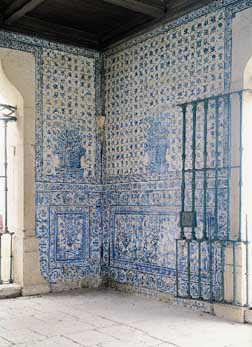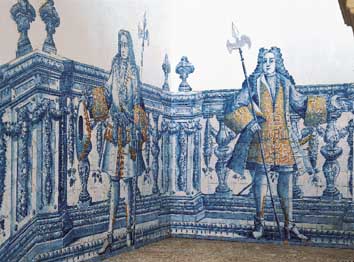|
|
|
|
|
|
|
|
|
|
|
|
|
|
 |
|
|
|
|
|
|
|
|
|
|
 |
|
|
|
|
|
|
|
|
|
|
The XVIII Century
The "Great Production"
of Tiles during the Reign of king Dom João V
|
 he second quarter of the XVIII century witnessed an unprecedented increase in the manufacture of Portuguese tiles, partly due to large orders from Brazil. he second quarter of the XVIII century witnessed an unprecedented increase in the manufacture of Portuguese tiles, partly due to large orders from Brazil.
This was the period of the so-called ?Great Production", which overlapped the reign of King Dom João V (1706-1750) and saw the execution of the largest cycles of historical panels ever employed in Portugal.
This increase in output led to the repetition of the same conformations, the use of ordered motifs like "albarradas" (vases of flowers) and the simplification of the painting of the scenes themselves. The surrounding frames also took on a major scenographic importance.
The continuation of the "Cycle of the Masters" can be seen in the quality of the work of a number of later painters such as Nicolau de Freitas, Teotónio dos Santos and Valentim de Almeida.
Alongside the religious themes ordered by the Church, the tiles used to decorate palaces began to employ more bucolic, mythological, hunting and war-like scenes, as well as those taken from daily life at court. This was particularly obvious in the so-called "welcoming figures" placed in the entrances to buildings.
|
|
|
|
Staircase, Palace of the Marquises of Minas, Lisbon,
"PMP", 1st quarter of the XVIII century.
photograph: Nicolas Lemonnier
|
|
|
|
 |
|
|
|
|
|
|
|
|
|
|
|
 |
|
|
|
|
|
|
|
"Welcoming" figures, Staircase, Archiepiscopal Palace,
Santo Antão do Tojal, c. 1730.
photograph: Nicolas Lemonnier
|
|
|
|
|
|
|
|
|
 |
|
|
 |
|
|
|
|
"Albarradas", Church of the Archiepiscopal Palace, Santo Antão do Tojal,
st half of the XVIII century.
ohotograph: Nicolas Lemonnie
|
|
|
|
|
|
|
|
|
Staircase, Palace of the Marquises of Minas, Lisbon,
Mid xviii century.
photograph: Nicolas Lemonnier
|
|
|
|
|
|
|
|
|
|
|
© Instituto Camões, 2000
|
|
|
|
|